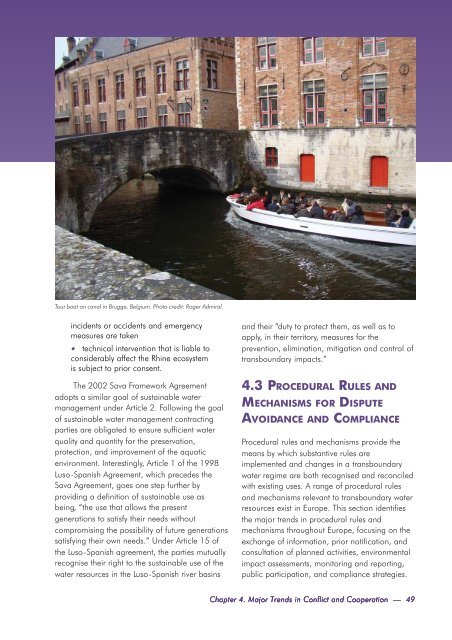Europe - UNEP
Europe - UNEP
Europe - UNEP
Create successful ePaper yourself
Turn your PDF publications into a flip-book with our unique Google optimized e-Paper software.
Tour boat on canal in Brugge, Belgium. Photo credit: Roger Admiral.<br />
incidents or accidents and emergency<br />
measures are taken<br />
• technical intervention that is liable to<br />
considerably affect the Rhine ecosystem<br />
is subject to prior consent.<br />
The 2002 Sava Framework Agreement<br />
adopts a similar goal of sustainable water<br />
management under Article 2. Following the goal<br />
of sustainable water management contracting<br />
parties are obligated to ensure sufficient water<br />
quality and quantity for the preservation,<br />
protection, and improvement of the aquatic<br />
environment. Interestingly, Article 1 of the 1998<br />
Luso-Spanish Agreement, which precedes the<br />
Sava Agreement, goes one step further by<br />
providing a definition of sustainable use as<br />
being, “the use that allows the present<br />
generations to satisfy their needs without<br />
compromising the possibility of future generations<br />
satisfying their own needs.” Under Article 15 of<br />
the Luso-Spanish agreement, the parties mutually<br />
recognise their right to the sustainable use of the<br />
water resources in the Luso-Spanish river basins<br />
and their “duty to protect them, as well as to<br />
apply, in their territory, measures for the<br />
prevention, elimination, mitigation and control of<br />
transboundary impacts.”<br />
4.3 PROCEDURAL RULES AND<br />
MECHANISMS FOR DISPUTE<br />
AVOIDANCE AND COMPLIANCE<br />
Procedural rules and mechanisms provide the<br />
means by which substantive rules are<br />
implemented and changes in a transboundary<br />
water regime are both recognised and reconciled<br />
with existing uses. A range of procedural rules<br />
and mechanisms relevant to transboundary water<br />
resources exist in <strong>Europe</strong>. This section identifies<br />
the major trends in procedural rules and<br />
mechanisms throughout <strong>Europe</strong>, focusing on the<br />
exchange of information, prior notification, and<br />
consultation of planned activities, environmental<br />
impact assessments, monitoring and reporting,<br />
public participation, and compliance strategies.<br />
Chapter 4. Major Trends in Conflict and Cooperation — 49
















